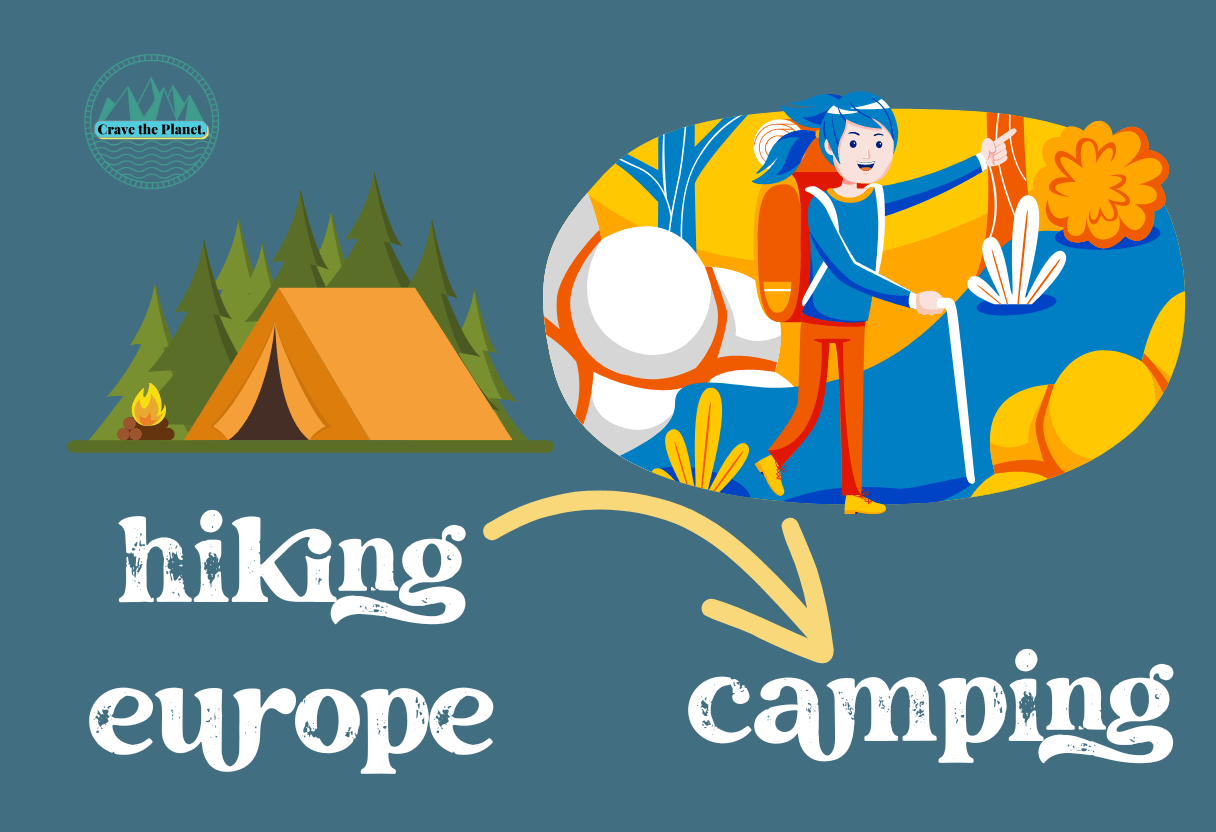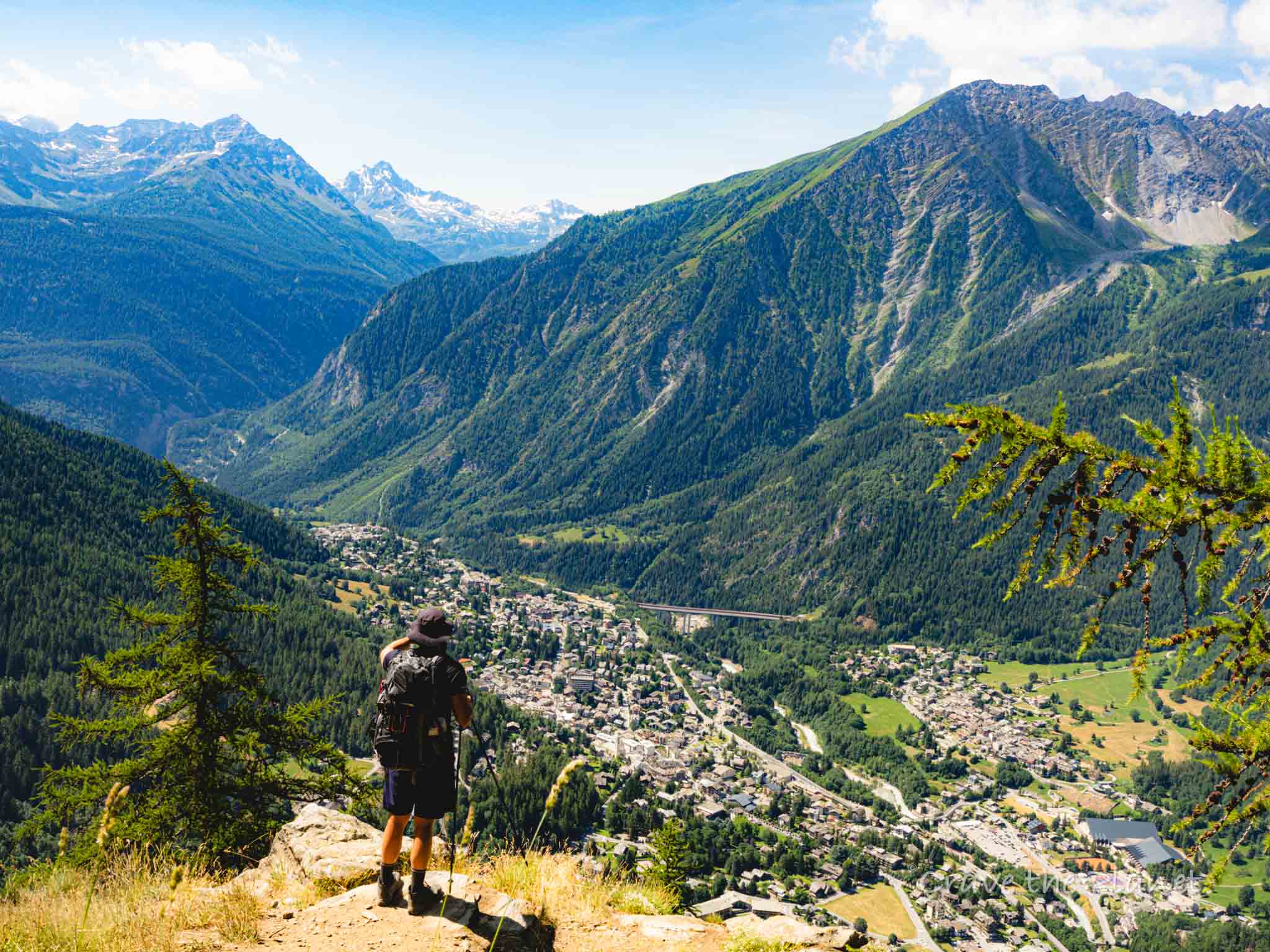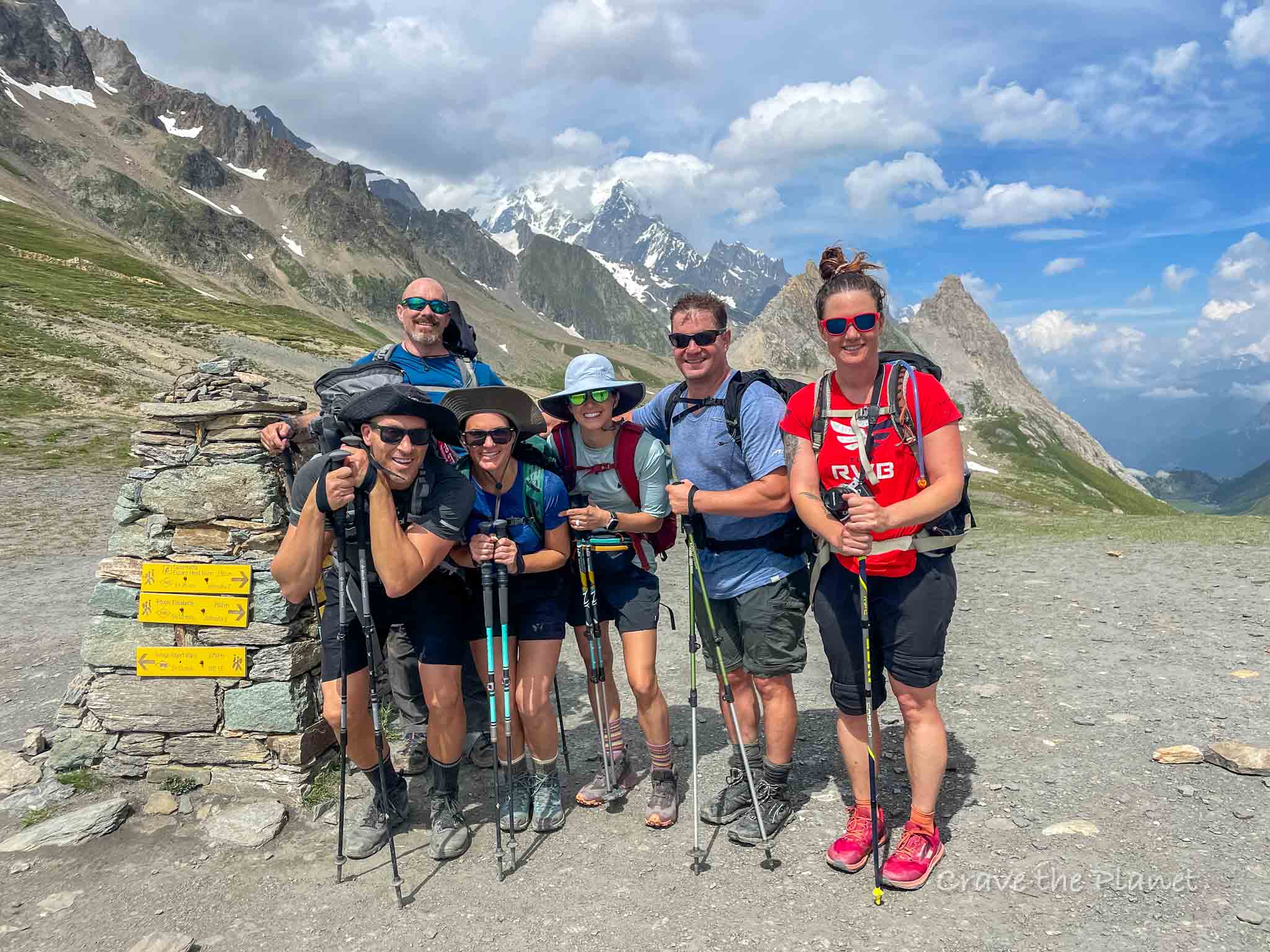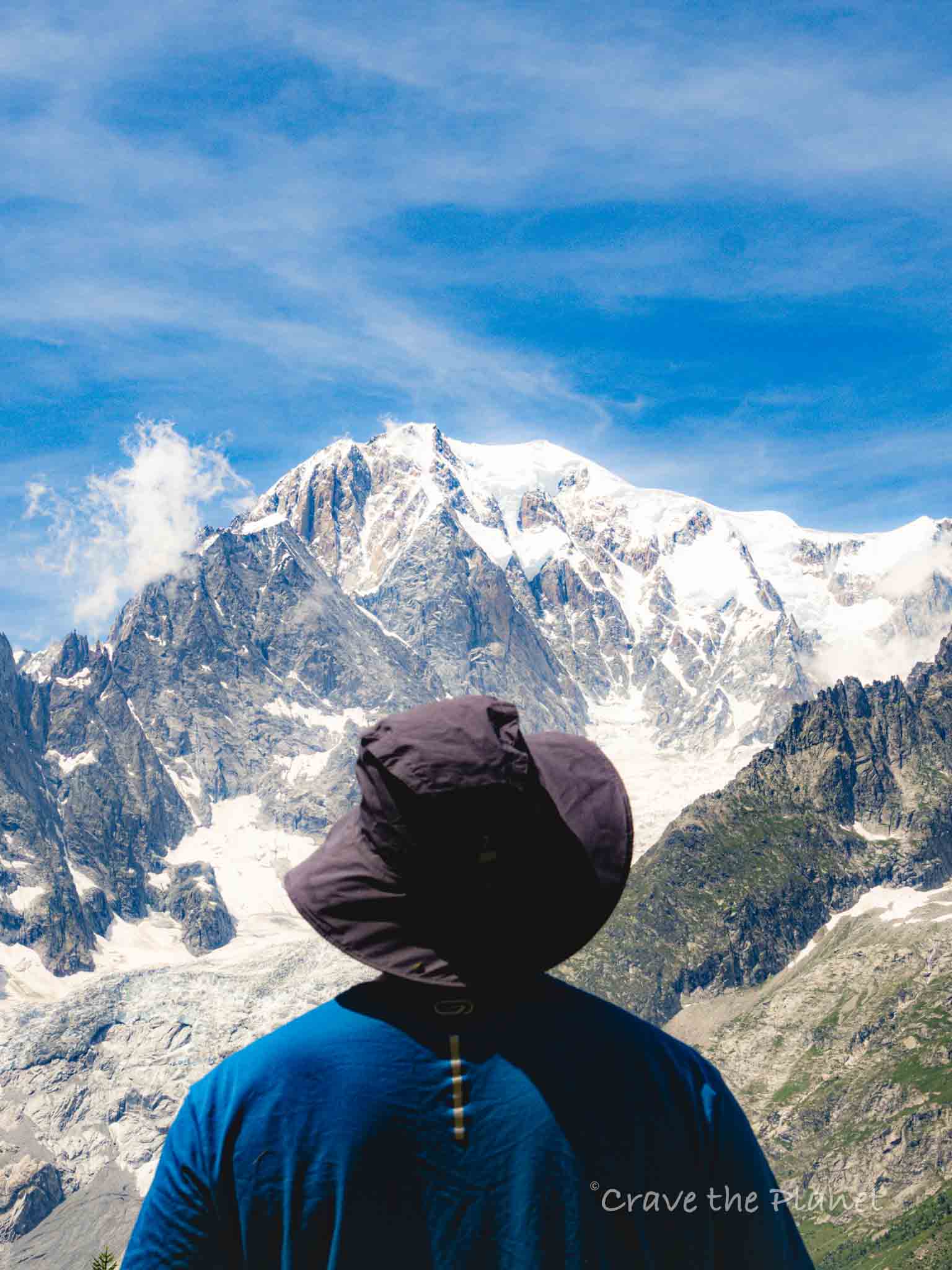Experience the iconic Tour du Mont Blanc like never before with a camping tour that takes you through the heart of the Alps, offering an unforgettable adventure amidst some of Europe’s most stunning landscapes.
Most people stay in huts when hiking the TMB – but this guide will help you avoid the crowded huts by camping the Tour du Mont Blanc for more peace. You’ll find a mix of higher elevation wild camping near refuges and campgrounds in the valleys.
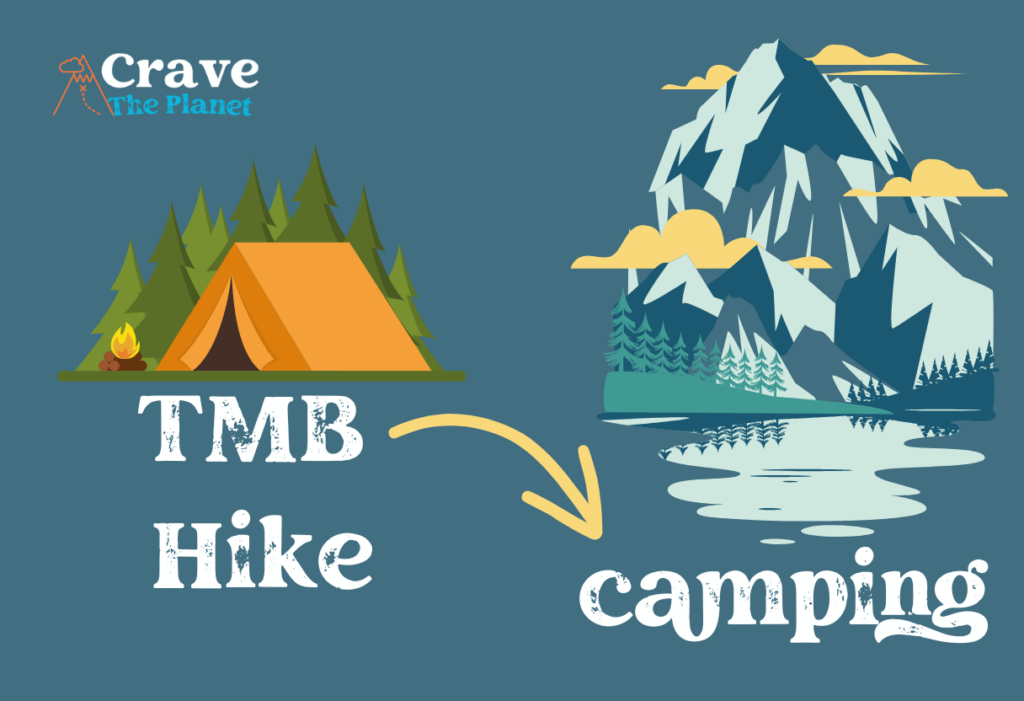
Over 11 days, you traverse high mountain passes, explore charming alpine villages, and enjoy exquisite local cuisine, all while making your camping spot under the vast, starry sky each night. You can download this app to find allowable wild camping.
Mobile Friendly TMB Camping Guide
HEY THERE! Are you sure you’re ready to start planning your TMB adventure? GET my free e-book with all the deets!
Sign up with email to download our definitive TMB Camping Guide now and unlock the secrets to the perfect camping spots, insider tips, and must-have amenities that will elevate your Tour du Mont Blanc hike into the experience of a lifetime!
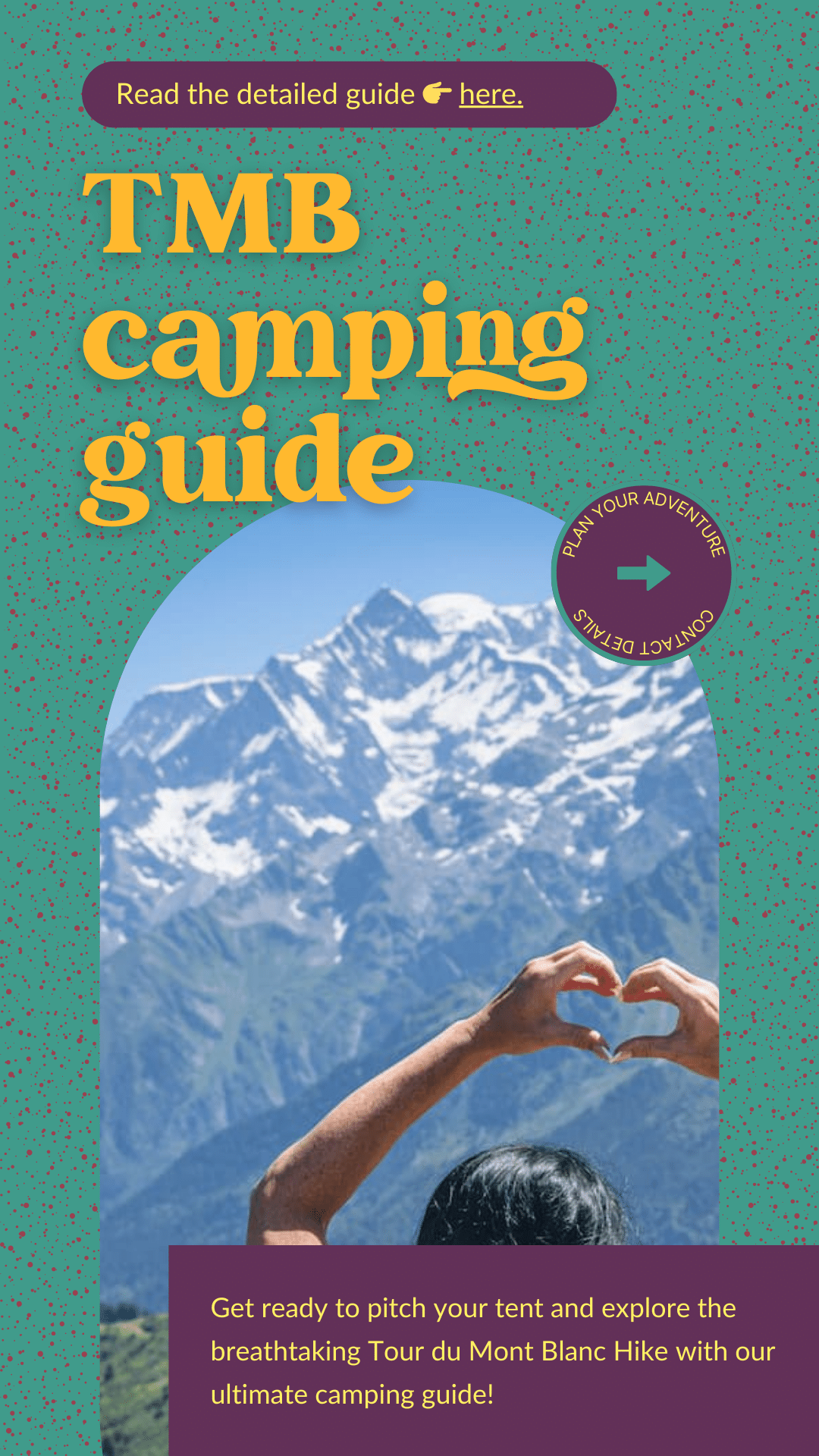
Quick Guide to Camping the Tour du Mont Blanc
The trek promises to be a fulfilling challenge that rewards you with unparalleled natural beauty and a sense of accomplishment.
Navigating the Tour du Mont Blanc means traversing international borders and a mosaic of local jurisdictions, all with unique camping regulations. It’s wise to inquire about the specific camping policies at each refuge and village you encounter. Also, always seek permission from landowners before setting up your tent on their land.
Here’s a general guideline to the camping rules across the three countries you’ll cross:
- In France, you’re allowed to bivouac from sunset until sunrise.
- Italy permits bivouacking above 2,500 meters, also from sunset to sunrise.
- In Switzerland, bivouacking is not allowed.
TMB Camping Map
Use this resource to plan your camping version of the Tour du Mont Blanc hike.
How to use this map: Use your computer mouse or fingers to zoom in and out. Click on the icons to get more information. Click the arrow on the top left corner for the written index. Click the star next to the title of the map to add this map to your google maps account. To view the saved map on your smartphone or PC, open google maps, click the menu button, and go to “your places”/ “maps.”
List of camping locations along TMB. Read further down for an explanation of where they are and links to their sites to book a spot.
- Camping Des Glaciers
- Camping Grandes Jorasses
- Camping Relais d’Arpette
- Refuge de la Balme wild camping
- Refuge La Flegere
- Les Chapieux camping
- Hotel de la Forclaz Camping
- Camping Hobo
- Auberge La Boerne
- Camping de la Mer de Glace
- Camping Bellevue
- Camping du Glacier
- Nant Borrant wild camping
- Camping Les Arolles
- Camping Aiguille Noire
- Refuge de la Croix du Bonhomme
- Camping Mont Blanc La Sorgente
- Camping Les Roccallies
- Camping Le Pontet
- Le Peuty camping
Preparing for this camping journey requires careful planning and a spirit ready for the outdoors.
By choosing to pitch a tent, you deepen your connection with the environment and enhance the immersive experience of being in the wilderness.
In addition to campgrounds, this guide will also share:
- Essentials for the Trek
- The Advantages of Tenting on the Trail
- Locations for Overnight Tenting
- Regulations on Undesignated Tenting
- Locating Tent Pitches
- Gear for Overnight Hiking
- Food and Beverages Tips
- Managing Your Expenses
There are many different rules about camping in Europe and campgrounds can be crowded. You do need to reserve them often. Wild camping is prohibited or limited by elevation, region or culture in many places but people still do wild camp.
Not really my favorite thing for hut to hut trails in Europe. The huts are quite often the best part of the hiking trip.
- Price is good
- Quiet
- More Flexibilty
- Wild camping is tricky
- Rules change
- harder and heavier pack
Exploring the Tour du Mont Blanc
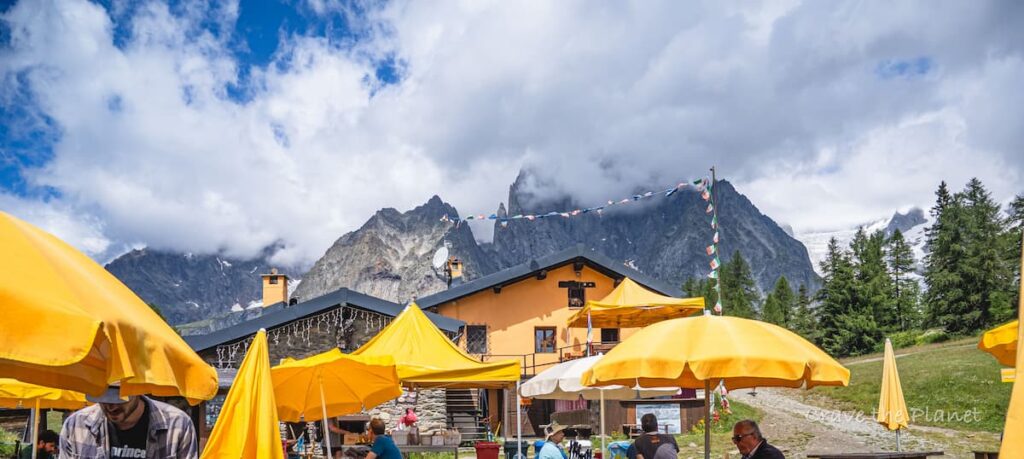
Embarking on the Tour du Mont Blanc (TMB), you’ll experience a globally renowned trail spanning across three countries: France, Italy, and Switzerland. This route encircles the majestic Mont Blanc, Europe’s towering beacon reaching skyward with its snow-capped peak.
On your journey, you traverse 11 segments, each presenting its own unique spectacle of the Alps’ raw beauty. As you navigate various mountain passes like Col de la Seigne and Fenêtre d’Arpette, the path takes you through picturesque valleys dotted with inviting villages, offering cultural discoveries and local flavors.
Prepare to be charmed by hamlets that dot the valleys, scale rugged landscapes, and indulge in the distinctive Alpine experience that the Tour du Mont Blanc expertly curates.
More Tour du Mont Blanc Travel Blogs
Why go Camping on the Tour du Mont Blanc?
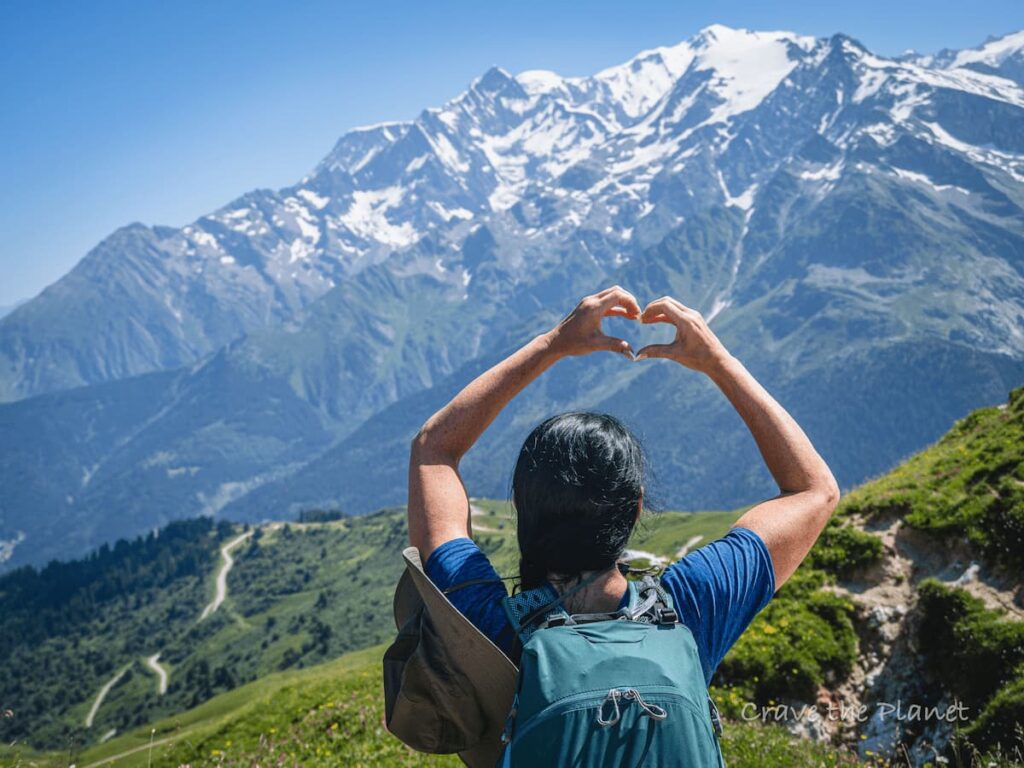
1. Escape the Refuge Reservations
Bypassing the intense competition to book huts on the Tour du Mont Blanc is one of the primary benefits of choosing to camp.
Securing accommodation in mountain refuges is an increasingly competitive ordeal with slots filling up months in advance, limiting your spontaneity.
By contrast, with a tent in your pack, you can enjoy the freedom of hiking without the stress of locking in your sleeping spots so far ahead of time.
2. Embrace the Flexibility of the Trail
The ability to adapt to the unexpected during your trek is a key advantage of camping. Changeable mountain weather, varying personal pace, or a surprise blister can all impact your day’s plan.
On a refuge-dependent trek, alterations in your itinerary can cause ripple effects.
But with your shelter on your back, your plan stays as fluid as the mountain streams, and it’s always just the right time to pitch camp and rest.
3. Substantial Savings
Camping along the Tour du Mont Blanc is notably kinder to your wallet compared to the costs of staying in refuges.
While you swap some home comforts for the embrace of nature, the financial savings are considerable.
Backpacking in this way lets you extend your adventure or allocate your budget to other experiences, making that challenge of the Mont Blanc trek both rewarding and economical.
Complete Guide to Camping Along the Tour du Mont Blanc Trail
– Clockwise Direction
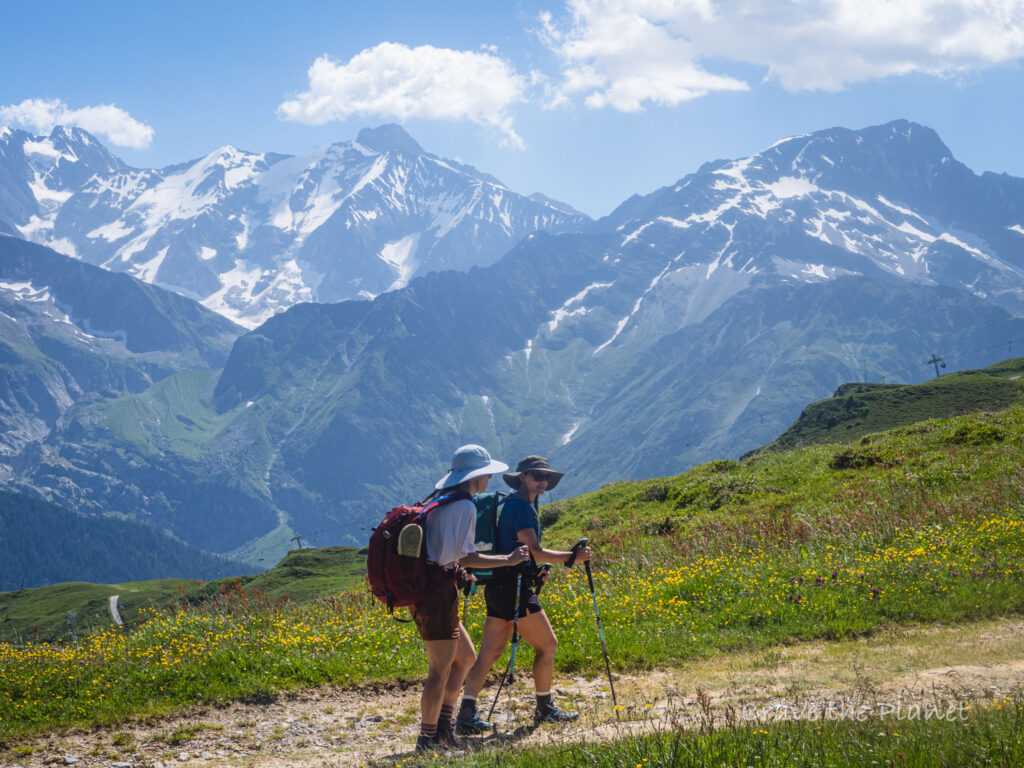
This guide lists campgrounds and wild camping spots that are allowed in the clockwise direction.
1. Accommodations in Les Houches & Chamonix
Your journey begins at Les Houches, a short bus ride from the bustling town of Chamonix. You have a variety of camping facilities to choose from, with amenities that ensure comfort at the start of your hike.
- Camping Les Arolles is nestled within Chamonix itself, providing the luxury of proximity to shops and entertainment alongside free WiFi and a washing area. If you prefer a quieter setting, opt for more campgrounds towards Les Bossons, accessible by bus.
- In Les Houches, prepare for an early trail start by staying at Camping Bellevue, the primary camping site in the area. Located at the base of the Bellevue cable car, this campground offers basic sanitary facilities and charging stations.
- For a unique experience, consider wild camping near Refuge de Miage if you take the Col de Tricot alternate route—be mindful of environmental stewardship and utilize available public amenities responsibly.
2. Campsites in the Les Contamines Area
As you reach Les Contamines, Camping Le Pontet serves as a traditional rest point. Situated past the town, it provides easy access to town amenities and offers a starting advantage for the next day’s trek. Services include showers, a café, and charging stations.
Adventurous spirits seeking a semblance of wild camping might press on to the Nant Borrant or Refuge de la Balme areas. Legal wild camping zones are available adjacent to the refuges, with potable water and toilets close by.
3. Pitching Your Tent Near Les Chapieux
Upon completion of stage two, Les Chapieux presents free camping opportunities next to the local tourist office.
If ending your day earlier is preferred, bivouac at Refuge de la Croix du Bonhomme, keeping environmental considerations in mind.
4. Options Near Rifugio Elisabetta & Val Veny
Campers tackling the third stage of the Tour du Mont Blanc (TMB) face a dilemma, as pitching tents at Rifugio Elisabetta is not an option, and the surrounding area lacks towns or official campgrounds. To navigate this issue, campers have a practical alternative:
One can divert to the Val Veny, which is home to three campgrounds and lies just off the primary TMB trail. This detour means covering an additional 4-5 miles beyond the usual stopping point for stage three. The extension, however, involves mainly easy road walking or gentle descents.
By choosing this route, hikers will veer away from the standard TMB path and make their way down into the scenic Veny Valley. Once there, they can either continue on foot or take a bus to reach any of the three campgrounds available in the area.
Your Options
Our favorite camping spot in Val Veny is Camping Aiguille Noire, chosen especially for its accessibility to both the trail and public transportation options. Additionally, it offers an excellent overnight experience with amenities like a fully supplied grocery store, a bar/restaurant, and high-quality restroom and shower facilities.
If you’re seeking a serene retreat away from the bustle, consider Camping Mont Blanc La Sorgente in Val Veny. While it may be a tad less accessible for Tour du Mont Blanc trekkers, being nestled further down the valley and away from the main thoroughfare, the tranquility it offers could be just the reward for those willing to embrace a little more legwork.
Nestled right next to Camping Aiguille Noire, Camping Hobo offers a warm welcome to TMB campers with its more rustic charm. Don’t let the simplicity fool you; the amiable and attentive staff ensure a delightful stay, making it a perfect spot to set up camp under the stars.
You’ll find all the essential amenities for a comfortable camping experience, ensuring you’re well-rested and ready to easily hop back onto the TMB trail for your next day’s adventure.
Courmayeur
The vibrant town of Courmayeur does not have any campgrounds. Choosing a hotel here allows you to experience the area’s rich cultural atmosphere along with the essential services for a comfortable stay.
5. Val Ferret
👉 ❌ This is a bit of a chokepoint for campers.
Stays Near Rifugio Bonatti
As the trail brings you closer to Rifugio Bonatti, allow yourself to get a drink on their deck before decending down into Val Ferret to rest at nearby camping grounds. Take in the views of the Italian side of Mont Blanc from this ideal vantage point.
Alternative to Bonatti
Campers on the TMB, take note: the stretch between Courmayeur and La Fouly lacks official camping sites, posing a bit of a logistical puzzle due to scarce nearby towns and bus links. But don’t fret, we’ve outlined your best bets:
For those keen on camping during this leg of the TMB, Camping Grandes Jorasses in Val Ferret is your nearest and most practical option. To stay on track with the main route and keep camping nightly, try this strategy:
- After stage four, catch a bus from Courmayeur to your chosen campsite in either Val Veny or Val Ferret, then bus back the next morning to resume the hike.
- At the end of stage five, near Rifugio Bonatti, follow a connecting trail down to Val Ferret to reach Camping Grandes Jorasses by bus or foot.
- On the following day, hop on the bus from Camping Grandes Jorasses to the Arp Nouvaz stop to rejoin the TMB and continue towards La Fouly.
If you can’t get into Camping Grandes Jorasses, you can also try Camping Tronchey but it’s more basic.
6. Establishing Base at La Fouly
In the Swiss village of La Fouly, campers find solace in the charming local campsites. Enjoy the amenities provided while basking in the serene backdrop of the Swiss Alps.
Camping des Glaciers is a party! It may seem bustling upon arrival, teeming with energetic kids, pets, and camping vans, but it compensates with its choice of level, shaded pitches and spectacular views.
For a more peaceful experience, we suggest setting up camp by the river to mask any surrounding sounds. Although the camp office takes a midday break, you’re free to pick a spot, get settled, and access the amenities prior to official check-in.
Just a short ten-minute stroll away, the town center provides additional conveniences, including dining options, an ATM, and a grocery store for all your needs.
7. Campgrounds at Champex-Lac: 2 Choices
Another picturesque spot lies at Champex-Lac. Here, the campsites grant you access to refreshing lake views and the tranquil sounds of nature, all the while ensuring your journey’s convenience and comfort.
- Camping Les Rocailles sits at the edge of Champex, a brief 20-minute stroll beyond the town center—anticipate this extra leg to stave off any end-of-hike impatience. Your reward is an early jump on tomorrow’s trail.
This charming campground features three terraced areas with ample flat space for tents, although shade is sparse. For those eager to get a jump on the Fenêtre d’Arpette variant, consider pushing on further using the alternative outlined below.
And a gentle reminder: you’re in Switzerland, where the rates at Camping Les Rocailles are a testament to the country’s standard of living!
- Choosing the Relais d’Arpette campground is ideal for those targeting the Fenêtre d’Arpette trail the next day, given its location off the primary TMB trail. Accessible via a mild 45-minute uphill hike from Champex, just track the trail signs for Fenêtre d’Arpette. Remember to gather supplies in Champex, as it’s the last significant town on the TMB before reaching Les Houches.
8. Camping at Col de la Forclaz, Trient & Le Peuty
The areas of Col de la Forclaz, Trient, and Le Peuty offer campers various facilities along the route. Whether you’re seeking full service or a more rustic experience, these sites cater to a range of preferences.
- Indulge in a touch of luxury at the Hotel Col de la Forclaz campsite, the more upscale choice on this TMB stage. Delight in amenities like pristine toilets, refreshing showers, and the convenience of adding hotel breakfast or dinner to your stay.
Discover the onsite shop for snacking and sundry needs. Plus, its proximity to Champex means a lighter hiking day for you. However, if you’re eyeing the Fenêtre d’Arpette variant, take note: choosing this campsite would require a half-mile backtrack along the main TMB route to reach the comforts of Hotel Col de la Forclaz.
Or, head to the tiny hamlet of Le Peuty.
- Enjoy the rustic charm and wallet-friendly rates of camping in the meadow beside Refuge Le Peuty, costing just half of what you’d spend at Hotel de la Forclaz. The facilities here are modest, offering a refreshing break from the more bustling campgrounds encountered earlier on the trail. To find your way to this tranquil spot, continue your descent for 30-40 minutes past Col de la Forclaz.
The campground is essentially an unmarked field. Simply set up your tent upon arrival, and a staff member will come by later to collect the fee, accepting both CHF and Euros.
9. Finding Your Spot at Tré-le-Champ & Argentiere
Tré-le-Champ and Argentiere are home to camping locations that serve as a perfect stop for those traversing the French sections of the trail. Take advantage of the amenities and rest up for the trails ahead.
- Find comfort and convenience at this snug La Boerne Table & Auberge in tre-le-champ, where camping is just a stone’s throw from the trail, complemented by breathtaking views of the Aiguille Verte from its lush, grassy sites.
- Camping du Glaciers in Argentière is highly praised for being a spacious campsite with a wealth of fantastic facilities. Though it requires an additional 25-minute detour from the trail (and a return trip the following day), the reward is the convenience of Argentière’s extensive amenities right at your doorstep.
10. Around Refuge La Flégère
For a stay closer to the high mountains, consider the area surrounding Refuge La Flégère. Here, you’ll find the perfect blend of wilderness and sleeping near refuges. You can also take a gondola down to the valley for established campgrounds.
- Camping de la Mer de Glace (Les Praz) is a short gondola ride away and 15 min from the valley station.
- Refuge La Flégère has all the normal hut services and allows overnight bivouacking.
Concluding Your TMB Trek
Once you’ve completed your circuit of the Tour du Mont Blanc, various accommodations are available. Seek out places that offer a space to reflect on your achievement and recuperate before your onward journey.
I’d recommend a spa hotel in Chamonix 🙂
Guidelines for Wild Camping During Your Trek
Experiencing the Tour du Mont Blanc (TMB) involves navigating a mosaic of regulations that concern wild camping. As the path weaves through France, Italy, and Switzerland, it’s crucial to honor the diverse local mandates you’ll encounter.
- In France, the freedom to camp in the wild is often reserved for higher elevations, only from sunset until sunrise.
- Over in Italy, post up your tent above 2,500 meters as twilight fades, and take it down with the first light. However, bear in mind that Switzerland upholds a stringent ban on such spontaneous encampments.
- For those near Chamonix, a quick registration via the Chamonix App is mandatory before you commence camping. This digital tool is an invaluable resource, detailing specific zones that welcome wild camping, areas where it’s discouraged, and spots where it’s expressly prohibited.
The TMB offers abundant authorized campgrounds along its route. Utilizing these sites supports local townships and contributes to preserving the delicate alpine ecosystem.
Besides, numerous designated areas permit free camping, giving you the opportunity to immerse in nature without infringing on regulations.
f you opt to camp outside these allocated spots, your responsibility to set up at sundown and depart at dawn is paramount, along with a strict adherence to leave-no-trace principles.
Here are some officially recognized spots for you to consider:
- Chalet Miage on the Col de Tricot path
- Refuge Nant Borrant
- Refuge de la Balme
- Refuge de la Croix du Bonhomme
- Les Chapieux
- Refuge la Flégère
- Reserve Naturelle des Aiguilles Rouges between 7 p.m. and 9 a.m.
While you may encounter seemingly perfect settings for a night under the stars, diligence in abiding by local laws ensures a sustainable future for the trail and its surrounding environments.
Locating Campsites on the TMB Trail
Selecting a place to rest each night while you traverse the renowned Tour du Mont Blanc (TMB) may require brief deviations from the main path. This is particularly true in the regions encircling Courmayeur and Chamonix.
To make your journey smoother, incorporating a reliable GPS navigation app into your toolkit is crucial, and Gaia GPS comes highly recommended for this purpose.
When utilizing a GPS app complemented with tailored GPS files, your screen becomes an invaluable map. These files detail all campsite locations along your journey and offer precise directions to access sites off the primary trail. With this technology, your waypoints are marked, and connecting trails to each campsite are easy to follow.
Such an advanced setup not only enhances your route clarity but also ensures you remain oriented towards your next destination with ease. Walking on the TMB with a pre-downloaded GPS map significantly eases navigation, especially when no internet connection is available.
For complete peace of mind and ease of navigation while on the Tour du Mont Blanc, acquiring a comprehensive camping guide might prove beneficial. However, should you prefer a more simplified aid, a standard GPS file covering the entire trail is an alternative offering.
With these navigational resources, determining how far and where to journey before you can unwind at your campsite becomes a trouble-free part of your adventure.
Essential Camping Gear for the Tour du Mont Blanc
Assessing Your Pack’s Weight
Determining the ideal backpack weight involves various factors based on personal hiking pace, experience, and any pre-existing injuries. Strive to maintain your pack’s total weight under 25 pounds, including water, to ensure comfort and avoid strain. If you have a history of injuries, aim for a pack weight less than 20 pounds. Remember, lighter packs contribute to a quicker pace on the trail.
Choosing the Right Tent
When selecting a tent for the TMB, prioritize a model with a sturdy rain fly and a lower profile to counteract wind. Ensure it is light enough to carry comfortably across varied terrains daily. Heavy-duty stakes and a durable ground cover are advised, especially for wild camping or bivouac sites. Brands such as MSR, Big Agnes, and Sierra Designs offer reliable backpacking tents with the MSR Hubba Hubba standing out for its balance of lightness and durability.
Selecting a Sleeping Bag
Your sleeping bag should accommodate temperatures ranging from -5 to 5 degrees Celsius for a comfortable night’s sleep in most conditions on the TMB. If you tend to sleep warm, a bag rated around 10 degrees Celsius may suffice, but always pair it with an insulated sleeping pad or a sleep sac to safeguard against the cold ground.
Read ➡️ Best Summer Sleeping Bags
Recommended Gear for TMB Camping
- Battery Backup: Keep your devices charged with a quality power bank like the BioLite Charge 80, as electronic charging opportunities may be scarce at campsites.
- Trekking Poles: Reduce the impact on your knees and improve balance on steep trails with the aid of trekking poles.
- Merino Wool Socks: To prevent blisters and discomfort, invest in Smartwool Hiking socks made from merino wool for their blend of comfort and durability.
| Item | Description |
|---|---|
| Power Bank | BioLite Charge 80: Charges phones up to 5 times |
| Socks | Smartwool Merino: Comfortable, durable merino wool blend |
| Jacket | Puffy Down: Lightweight and packable for warmth |
| Guidebook | Andrew McCluggage’ TMB Guide: Comprehensive trail advice |
| Travel Insurance | Recommended for protection against unexpected travel issues |
Other essentials include a puffy down jacket for warmth without the bulk and the Knife edge guidebook by Andrew Mccluggage for insightful trail guidance. Lastly, secure travel insurance for peace of mind against unforeseen events during your adventure.
Remember: Handling the basics well can make a significant difference in your hiking experience. Proper gear setup keeps you safe and comfortable, allowing you to fully enjoy the majestic Tour du Mont Blanc.
Rescue Insurance [Protect Your Body and Health]
It’s a very good idea to get insurance for this trip just in case you twist an ankle or worse on the trail. Parts of these trails are totally inaccessible to vehicles so if you did get hurt you would have to get a helicopter rescue.
Crave the Planet partners with Global Rescue to offer the world’s leading travel protection services. Medical and security emergencies happen. When they do, we rely on Global Rescue to provide our clients with medical, security, travel risk and crisis response services. Without a membership, an emergency evacuation could cost over $100,000. More than one million members trust Global Rescue to get them home safely when the unexpected happens.
👉 We highly recommend hikers enroll with Global Rescue for peace of mind.
Travel Insurance [Protect Your Wallet]
| TL;DR From Author
Don’t let unexpected changes derail your travel plans – with travel insurance you can have peace of mind knowing that you’re covered if you need to alter your bookings. Protect your investment and travel with confidence by securing travel insurance today.
Nourishment Along the TMB
Hydration Essentials
When embarking on the TMB, it’s crucial to maintain hydration. Fortunately, the trail is well-equipped with water sources, including potable water at accommodations and village fountains. It’s advisable to carry 1-2 liters of water daily to ensure you remain hydrated between these points.
Campers should be mindful that not all water sources are safe to drink unfiltered due to agricultural runoff near the trail. It’s recommended to have a compact and efficient water filter. A popular choice among hikers is the Sawyer Squeeze water filtration system, known for its simplicity and effectiveness.
Alongside water, campers have various food options. The route’s proximity to towns allows for regular resupply of provisions, effectively eliminating the need to transport an extensive supply of food.
For those who prefer to manage their budget, self-catering is a viable option. This entails bringing cooking equipment and a portable stove. Nearby shops, where available, provide ingredients for meals, which might include pasta, cheese, and fresh bread (pain).
Additionally, hikers can indulge in local delicacies by purchasing meals at hotels, gites, or refuges along the path. While lunches are typically available without prior arrangement, dinners often require an early reservation, especially if you’re not staying overnight. It’s important to note that some refuges may not serve campers, so planning ahead is essential.
Those who enjoy a glass of beer or wine will find that these are also part of the offerings at many resting points, enhancing the overall experience with local flavors.
Whether opting for self-prepared meals or enjoying local cuisine, the TMB promises to be as enriching for the palette as it is for the soul.
Financial Considerations for Your Journey
Payment: Cash or Cards?
When you’re trekking along the Tour du Mont Blanc, prepare to operate mostly with cash. While the trend of accepting cards is growing, you’ll find cash crucial, especially as ATMs can be scarce. Ensure you’re carrying enough to sustain your basic needs for multiple days.
Currency Variations
Embarking on the TMB, you traverse through three countries, which means handling different currencies. You start with Euros in France, switch to Swiss Francs in Switzerland, and back to Euros in Italy. It’s prudent to use local currency in Switzerland to benefit from favorable exchange rates, although they will accept Euros.
Managing Your Expense
While the TMB has a reputation for being on the more opulent side of hiking experiences, it’s feasible to adopt a cost-effective approach—mainly through opting to camp. This choice not only curtails your expenditure on accommodations significantly but also amplifies your connection with nature.
For meals, steer clear of frequent restaurant dining and instead indulge in local markets and stores for provisions. A self-prepared meal can dramatically reduce your costs while letting you enjoy the culinary delights of the region.
Remember, the trail’s best rewards, like the sweeping vistas atop a challenging pass, are available at no extra charge to you.
| Accommodation | Cost-Saving Tip |
|---|---|
| Camping | Considerably cuts lodging expenses, more immersive natural experience |
| Food & Drink | Budget Tip |
|---|---|
| Restaurant/Refuge | Limit visits, opt for cooking your own meals, occasional treats permissible |
Local delicacies like cheese are a must-try, and a celebratory drink post-hike is a tradition worth indulging in. But always balance it with homemade meals to keep your expenses in check.
Final Verdict: Ways to Book a Hut to Hut Hiking Trip
Self-Guided Tour Planning Service
- [Self-Guided] - You're on your own once you start
- Must book in Oct to Jan of year prior to hike
- Fully done for you route
- Service finds and books your huts
- Maps provided on app
- small groups (<10 typically)
- local Chamonix guides
- all transfers/breakfast/dinner/accommodations included
- airport transfer included
- stay in the insanely beautiful Rifugio Bonatti and other huts at high elevation
- Cheapest Option
- Most Freedom
- Take side excursions as you like
Camping
- campgrounds can be crowded
- reservations often needed in advance
- Wild camping is prohibited or limited by elevation
Common Inquiries on the Tour du Mont Blanc Trek
Best Shelters for Your Tour du Mont Blanc Hike
If you want to mix and match refuges and camping, when trekking the Tour du Mont Blanc (TMB), several refuges stand out for their hospitality and services. Notable ones include Refuge de la Croix du Bonhomme, which is known for its picturesque setting and warmth. Another recommended shelter is the Rifugio Elisabetta, offering remarkable views of the surrounding peaks and glaciers. It’s essential to book these in advance as they fill up quickly, particularly during peak hiking seasons.
Regulations on Wild Camping Along the TMB Trail
Wild camping is generally not permitted along the TMB route, especially within the national parks and nature reserves. However, some designated areas may allow bivouacking for a night, provided you set up at dusk and leave at dawn. Check local regulations before your hike to ensure compliance.
A Suggested Camping Schedule for Completing the TMB
An ideal camping itinerary for the TMB could involve staying at regulated campsites along the route. A common approach could include your first night at Les Houches, then Les Contamines, followed by stays at Courmayeur, La Fouly, and Trient, among others. This plan spaces out campsites reasonably, accounting for a moderate daily hiking pace.
Projected Camping Expenses on the TMB
Expect average costs for campsites to range from €5 to €25 per night. Keep in mind, though, prices can vary based on location and amenities offered. Additional expenditures may include food supplies, gear rental if needed, and transportation to and from the trailheads.
Challenging Segments of the TMB and Preparatory Advice
Parts of the TMB can be arduous, particularly ascents such as the Fenêtre d’Arpette or the climb to the Grand Col Ferret. Prepare by ensuring adequate fitness levels and packing suitable gear, including sturdy hiking boots and weather-appropriate clothing. Also, acclimating to higher altitudes can be beneficial.
Guidance Needs for the TMB Expedition
While a guide is not essential for experienced hikers, beginners might find it advantageous for navigation and safety reasons. Self-guided camping is viable, but it’s crucial to be well-prepared with maps, a good understanding of the terrain, and knowledge of local weather patterns.
More Resources
Discover gear that elevates your outdoor adventures. As a physical therapist, I’ve curated product comparisons to enhance safety and enjoyment, perfect for beginners or those with weary knees.
Physical Therapist Curated Gear Guides for Hikers & Skiers
- 🧎 Make your knees feel better while hiking and walking: Best Knee Braces for Hiking
- 🌳Make the downhills stop hurting and hike with more confidence Best Trekking Poles Review
- ⌚ Never get lost on the trail and navigate the wilderness safely with My Review of the Best GPS Watches for Hiking
- ❄️ Go hiking on uneven terrain safely: The Best Hiking Boots with Ankle Support
- Don’t get lost in the backcountry with : My Review of the Best 2 Way Radios for the Mountains
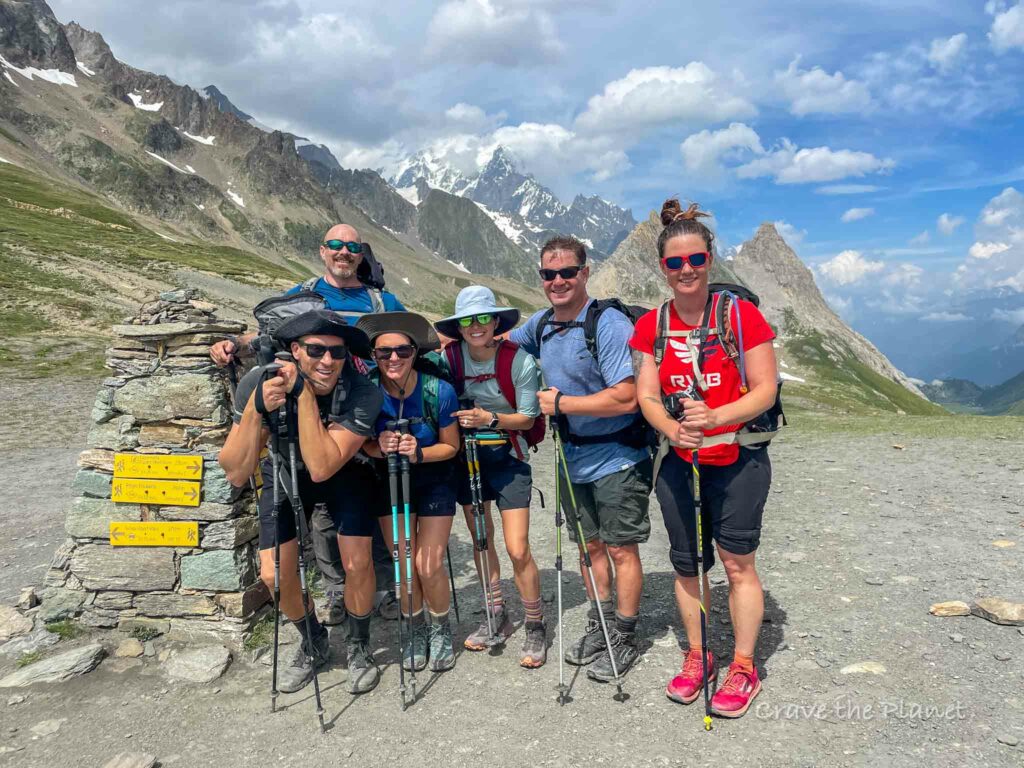
My Guides to Bucketlist Hikes in Europe
(That I’ve personally done and loved.)
We hope this guide filled with interesting information about camping the Tour du Mont Blanc given you the proper information to plan your next adventure.

Author profile: Morgan Fielder is a Doctor of Physical Therapy and passionate hiker who believes in exploring the world on foot with good food. Follow her journey as she shares science-based hiking tips and advocates for sustainable tourism.

